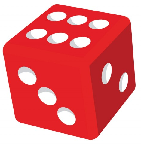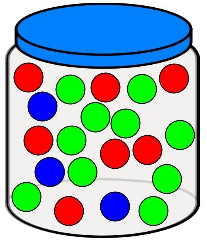

A: The number shown is a 6.
B: The number shown is greater than 4.
C: The number shown is less than 4.
Solutions: \(P(A)=\frac{1}{6}\approx16.7\%\); \(P(B)=\frac{2}{6}=\frac{1}{3}\approx33.3\%\); \(P(C)=\frac{3}{6}=\frac{1}{2}=50\%\)
A: The number shown is odd.
B: The number shown is a prime number.
C: The number shown is a solution of the equation \(x^2-8x+15=0\).
Solutions: \(P(A)=\frac{10}{20}=\frac{1}{2}=50\%\); \(P(B)=\frac{8}{20}=\frac{2}{5}=40\%\); \(P(C)=\frac{2}{20}=\frac{1}{10}=10\%\)
A: The numbers shown are 1 and 1.
B: The sum of the numbers shown is 3.
C: The sum of the numbers shown is 4.
D: The sum of the numbers shown is 5.
E: The numbers shown are equal.
Solutions: \(P(A)=\frac{1}{36}\); \(P(B)=\frac{2}{36}=\frac{1}{18}\); \(P(C)=\frac{3}{36}=\frac{1}{12}\); \(P(D)=\frac{4}{36}=\frac{1}{9}\); \(P(E)=\frac{6}{36}=\frac{1}{6}\)A: The sum of the numbers shown is 3.
B: The sum of the numbers shown is 4.
C: All three numbers shown are equal.
Solutions: \(P(A)=\frac{1}{216}\); \(P(B)=\frac{3}{216}=\frac{1}{72}\); \(P(C)=\frac{6}{216}=\frac{1}{36}\) A standard deck of 52 playing cards consists of four suits:
the hearts (♥), the diamonds (♦),
the spades (♠) and the clubs (♣).
Each suit includes thirteen cards labelled: A (ace or 1), 2, 3, 4, 5, 6, 7, 8, 9, 10, J (jack), Q (queen) and K (king).
We pick one card at random.
Find the probabilities of the following events:
A standard deck of 52 playing cards consists of four suits:
the hearts (♥), the diamonds (♦),
the spades (♠) and the clubs (♣).
Each suit includes thirteen cards labelled: A (ace or 1), 2, 3, 4, 5, 6, 7, 8, 9, 10, J (jack), Q (queen) and K (king).
We pick one card at random.
Find the probabilities of the following events:
A: The card is an ace.
B: The card is a spade.
C: The card is the queen of hearts.
D: The card is not a king.
Solutions: \(P(A)=\frac{4}{52}=\frac{1}{13}\); \(P(B)=\frac{13}{52}=\frac{1}{4}\); \(P(C)=\frac{1}{52}\); \(P(D)=\frac{48}{52}=\frac{12}{13}\)A: The number is a multiple of 5.
B: The number is not a multiple of 5.
Solutions: \(P(A)=\frac{2}{12}=\frac{1}{6}\); \(P(B)=P(A')=1-P(A)=\frac{10}{12}=\frac{5}{6}\)A: The card is an ace or a king.
B: The card is a spade or a club.
C: The card is a queen or a heart.
D: The card is neither a queen nor a heart.
Solutions: \(P(A)=\frac{8}{52}=\frac{2}{13}\); \(P(B)=\frac{26}{52}=\frac{1}{2}\); \(P(C)=\frac{16}{52}=\frac{4}{13}\); \(P(D)=\frac{36}{52}=\frac{9}{13}\)A: This student learns Russian.
B: This student learns Chinese.
C: This student learns both: Russian and Chinese.
D: This student learns exactly one of these two languages.
Solutions: \(P(A)=\frac{15}{20}=75\%\); \(P(B)=\frac{9}{20}=45\%\); \(P(C)=\frac{4}{20}=20\%\); \(P(D)=\frac{16}{20}=80\%\)A: This student plays football.
B: This student plays football or basketball.
C: This student plays basketball but not football.
D: This student plays exactly one of these two sports.
E: This student plays neither football nor basketball.
Solutions: \(P(A)=\frac{16}{25}=64\%\); \(P(B)=\frac{19}{25}=76\%\); \(P(C)=\frac{3}{25}=12\%\); \(P(D)=\frac{12}{25}=48\%\); \(P(E)=\frac{6}{25}=24\%\)A: This inhabitant reads both magazines.
B: This inhabitant reads at least one of these two magazines.
Solutions: \(P(A)=\frac{900}{6000}=15\%\); \(P(B)=\frac{4500}{6000}=75\%\) A jar contains 8 blue marbles, 7 red marbles and 5 green marbles.
Two marbles are extracted in a row. The first marble is replaced before extracting the second one.
Find the probabilities of the following events:
A jar contains 8 blue marbles, 7 red marbles and 5 green marbles.
Two marbles are extracted in a row. The first marble is replaced before extracting the second one.
Find the probabilities of the following events:
A: Both marbles are blue.
B: Both marbles are red.
C: Both marbles are green.
Solutions: \(P(A)=\frac{8}{20}\cdot\frac{8}{20}=16\%\); \(P(B)=\frac{7}{20}\cdot\frac{7}{20}=12.25\%\); \(P(C)=\frac{5}{20}\cdot\frac{5}{20}=6.25\%\)A: Both marbles are blue.
B: Both marbles are red.
C: Both marbles are green.
Solutions: \(P(A)=\frac{8}{20}\cdot\frac{7}{19}\approx14.7\%\); \(P(B)=\frac{7}{20}\cdot\frac{6}{19}\approx11.1\%\); \(P(C)=\frac{5}{20}\cdot\frac{4}{19}\approx5.26\%\)(a) if you replace each marble before extracting the next one,
(b) if you don't replace the marbles.
Solutions: (a) \(P(A)=\frac{7}{12}\cdot\frac{7}{12}\cdot\frac{7}{12}=\frac{343}{1728}\approx19.8\%\); (b) \(P(B)=\frac{7}{12}\cdot\frac{6}{11}\cdot\frac{5}{10}=\frac{7}{44}\approx15.9\%\)A: Both marbles are yellow.
B: The first is yellow and the second is blue.
C: At least one of the marbles is yellow.
Solutions: \(P(A)=\frac{7}{16}\cdot\frac{6}{15}=\frac{7}{40}=17.5\%\); \(P(B)=\frac{7}{16}\cdot\frac{5}{15}=\frac{7}{48}\approx14.6\%\); \(P(C)=1-\frac{9}{16}\cdot\frac{8}{15}=\frac{7}{10}=70\%\)A: All three numbers are even.
B: The first number is less than 10 and the other two numbers are greater than 10.
C: The first number is a multiple of 2, the second is a multiple of 3 and the third is a multiple of 4.
D: None of the numbers is a multiple of 9.
Solutions: \(P(A)=\frac{1}{8}=12.5\%\); \(P(B)=\frac{169}{1296}\approx13.0\%\); \(P(C)=\frac{1}{24}\approx4.17\%\); \(P(D)=\frac{512}{729}\approx70.2\%\)A: All three representatives are girls.
B: At least one of the representatives is a boy.
Solutions: \(P(A)=\frac{15}{25}\cdot\frac{14}{24}\cdot\frac{13}{23}=\frac{91}{460}\approx19.8\%\); \(P(B)=1-P(A)=\frac{369}{460}\approx80.2\%\)A: Both card are hearts.
B: Both cards are aces.
Solutions: \(P(A)=\frac{13}{52}\cdot\frac{12}{51}=\frac{1}{17}\approx5.88\%\); \(P(B)=\frac{4}{52}\cdot\frac{3}{51}=\frac{1}{221}\approx0.452\%\)A: Exactly one of the cards is an ace.
B: At least one of the cards is an ace.
Solutions: \(P(A)=\frac{4}{52}\cdot\frac{48}{51}\cdot\frac{47}{50}+\frac{48}{52}\cdot\frac{4}{51}\cdot\frac{47}{50}+\frac{48}{52}\cdot\frac{47}{51}\cdot\frac{4}{50} \approx20.4\%\); \(P(B)=1-\frac{48}{52}\cdot\frac{47}{51}\cdot\frac{46}{50}\approx21.7\%\)A: All representatives are girls.
B: All representatives are boys.
Solutions: \(P(A)=\frac{12\choose 4}{20\choose 4}\approx10.2\%\); \(P(B)=\frac{8\choose 4}{20\choose 4}\approx1.44\%\)A: All five cards are non-aces.
B: At least one of the cards is an ace.
Solutions: \(P(A)=\frac{48\choose 5}{52\choose 5}\approx65.9\%\); \(P(B)=1-P(A)\approx34.1\%\)(a) We choose an arbitrary student. Find the probability that this student likes prime numbers.
(b) We choose a male student. Find the probability that he likes prime numbers.
(c) We choose a female student. Find the probability that she likes prime numbers.
(d) We choose a student who likes prime numbers. Find the probability that this student is a female.
Solutions: (a) \(P(A)=\frac{133}{500}=26.6\%\); (b) \(P(A|M)=\frac{45}{225}=20\%\); (c) \(P(A|F)=\frac{88}{275}=32\%\); (d) \(P(F|A)=\frac{88}{133}\approx66.2\%\)(a) Find the probability that a person who died last year was a smoker.
(b) Find the probability that a person who died last year was a non-smoker.
(c) Find the probability that a person who died last year had lung cancer.
(d) Find the probability that a smoker who died last year had lung cancer.
(e) Find the probability that a person who died of lung cancer was a smoker.
Solutions: (a) \(P(S)=40\%\); (b) \(P(N)=60\%\); (c) \(P(L)=32\%\); (d) \(P(L|S)=74\%\); (e) \(P(S|L)=92.5\%\)(a) Find the probabilities of the following events:
A: the first number is even,
B: the second number is even.
(b) Show that events A and B are independent.
Solutions: (a) \(P(A)=\frac{4}{9},~ P(B)=\frac{4}{9}\); (b) \(P(A\cap B)=\frac{16}{81}=P(A)\cdot P(B)\), so the events are independent(a) Find the probabilities of the following events:
A: the first marble is black,
B: the second marble is black.
(b) Verify if events A and B are independent.
Solutions: (a) \(P(A)=\frac{4}{10},~ P(B)=\frac{4}{10}\); (b) \(P(A\cap B)=\frac{2}{15}\ne P(A)\cdot P(B)\), so the events are not independent(a) Find the probability of A, that a randomly chosen person reads the Morning Magazine.
(b) Find the probability of B, that a randomly chosen person reads the Evening events.
(c) Find the probability that a randomly chosen person reads both newspapers.
(d) Find the probability that a randomly chosen reader of the Evening Events reads the Morning Magazine, too.
(e) Verify if events A and B are independent.
Solutions: (a) \(P(A)=30\%\); (b) \(P(B)=40\%\); (c) \(P(A\cap B)=2\%\); (d) \(P(A|B)=5\%\); (e) \(P(A\cap B)\ne P(A)\cdot P(B)\), so the events are not independentB: this student plays basketball,
F: this student plays football.
(a) Calculate \(P(B),~ P(F)\) and \(P(B\cap F)\).
(b) Verify if events B and F are independent.
Solutions: (a) \(P(B)=\frac{1}{4},~ P(F)=\frac{2}{5},~ P(B\cap F)=\frac{1}{10}=P(B)\cdot P(F)\); (b) the events are independent(a) Draw the corresponding tree diagram.
(b) Find the probability that the chosen marble is black.
Solutions: (b) \(P(A)=\frac{3}{5}=60\%\)(a) Find the probability that this black marble was picked from the first jar.
(b) Find the probability that this black marble was picked from the second jar.
Solutions: (a) \(P(H_1|A)=\frac{1}{3}\approx33.3\%\); (b) \(P(H_2|A)=\frac{2}{3}\approx66.7\%\)(a) Find the probability that the second marble is red.
(b) Knowing that the second marble is red, find the probability that the first marble was red too.
Solutions: (a) \(P(A)=\frac{9}{40}=22.5\%\); (b) \(P(H_1|A)=\frac{1}{3}\approx33.3\%\)(a) Find the probability of getting a 6 exactly once.
(b) Find the probability of getting a 6 exactly twice.
(c) Find the probability of getting a 6 exactly three times
Solutions: (a) \(P(A)\approx40.2\%\); (b) \(P(B)\approx16.1\%\); (c) \(P(C)\approx3.22\%\) You toss a coin 4 times. Each time the coin can land in two different ways: one of the outcomes is called head and the other tail.
You toss a coin 4 times. Each time the coin can land in two different ways: one of the outcomes is called head and the other tail.
(a) Find the probability of getting four tails.
(b) Find the probability of getting at least one head.
(c) Find the probability of getting exactly one head.
(d) Find the probability of getting exactly two heads.
Solutions: (a) \(P(A)=\left(\frac{1}{2}\right)^4=\frac{1}{16}=6.25\%\); (b) \(P(B)=1-P(A)=\frac{15}{16}=93.75\%\); (c) \(P(C)=\frac{4}{16}=\frac{1}{4}=25\%\); (d) \(P(D)=\frac{6}{16}=\frac{3}{8}=37.5\%\)(a) Find his probability of making exactly two baskets.
(b) Find his probability of making exactly five baskets.
(c) Find his probability of making exactly six baskets.
Solutions: (a) \(P(A)\approx 1.06 \%\); (b) \(P(B)\approx 20.1\%\); (c) \(P(C)\approx 25.1\%\)